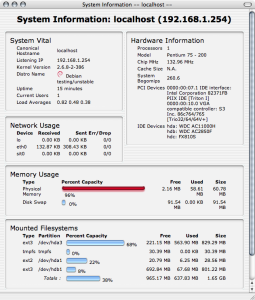A LAMP stack running any old PC, power, ethernet and port forwarding was (and continues to be) all you need to run a website.
2005
As a broke student I couldn’t just buy something nice and fast, so I cobbled together some old discarded PC parts from school. I ended up with a 132 MHz Pentium + 1.6 GB spread across two very slow hard drives, running Gentoo. I actually had to use distcc to compile Gentoo on another PC because it was just too slow otherwise.

I still remember how you would type onpaws.com into a browser and the CPU would peg at 100%; loading the WordPress index page took 4-5 seconds before any of my content would even show up.
2006
I managed to scrounge some marginally better hardware this year. PHP+Apache benefitted substantially from a noticeable speed increase. I also had the good fortune of using a much faster hard drive which was later successfully transplanted into the next few machines. (Try that on Windows XP.)
Specs were:
- Pentium 3 733 MHz
- 384 MB PC100 RAM
- 160 GB IDE HD
2007
My roommate asked me to fix his broken computer and in return I inherited it for several months. At this point, Gentoo had run its course but I had enough waiting for the cumbersome compile times. It was time to switch to a popular binary based distro: Ubuntu.
- Pentium 4 1.8 GHz
- 256 MB DDR333
- 160 GB HD (same one…)
Of course, he eventually wanted his machine back. But by the time I got to Seattle I landed an internship and could afford some more modern hardware. This time around it was:
- Sempron 64 2800+
- 512MB DDR400
- 160GB HD (still trucking)
- 300GB HD (to trial some successful media hosting experiments)
Late 2007-
Normally when your power goes out at home, its an inconvenience. But when you’re running a website at home a power outage can boot your site and online presence right off the net.
At this point I elected to simply put the responsibility in someone else’s hands: pay-as-you-go hosting with a decent provider: NearlyFreeSpeech.net. It’s shared hosting and it’s not as fast for me to develop on, but it’s worth it simply not having to shoulder the hardware burden anymore.